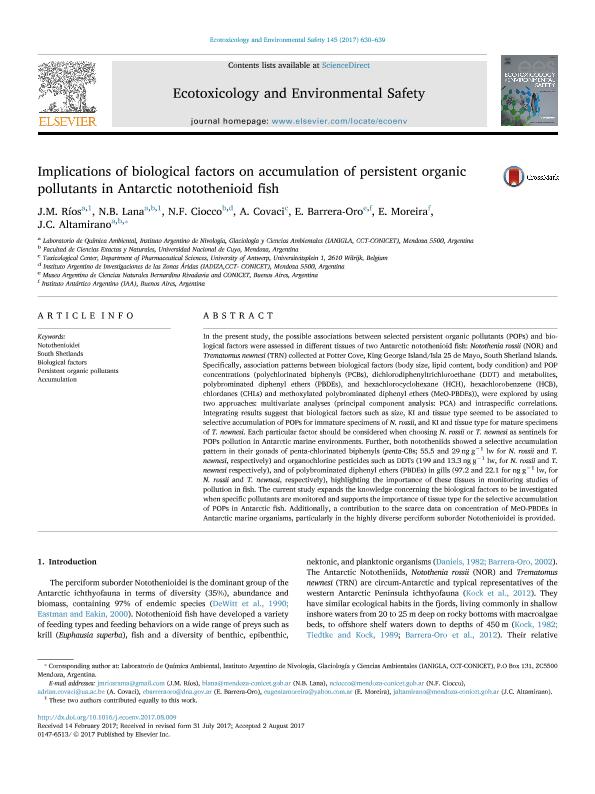Artículo
Implications of biological factors on accumulation of persistent organic pollutants in Antarctic notothenioid fish
Rios, Juan Manuel ; Lana, Nerina Belén
; Lana, Nerina Belén ; Ciocco, Nestor Fernando
; Ciocco, Nestor Fernando ; Covaci, A.; Barrera Oro, Esteban
; Covaci, A.; Barrera Oro, Esteban ; Moreira, María Eugenia
; Moreira, María Eugenia ; Altamirano, Jorgelina Cecilia
; Altamirano, Jorgelina Cecilia
 ; Lana, Nerina Belén
; Lana, Nerina Belén ; Ciocco, Nestor Fernando
; Ciocco, Nestor Fernando ; Covaci, A.; Barrera Oro, Esteban
; Covaci, A.; Barrera Oro, Esteban ; Moreira, María Eugenia
; Moreira, María Eugenia ; Altamirano, Jorgelina Cecilia
; Altamirano, Jorgelina Cecilia
Fecha de publicación:
11/2017
Editorial:
Academic Press Inc Elsevier Science
Revista:
Ecotoxicology and Environmental Safety
ISSN:
0147-6513
Idioma:
Inglés
Tipo de recurso:
Artículo publicado
Clasificación temática:
Resumen
In the present study, the possible associations between selected persistent organic pollutants (POPs) and biological factors were assessed in different tissues of two Antarctic notothenioid fish: Notothenia rossii (NOR) and Trematomus newnesi (TRN) collected at Potter Cove, King George Island/Isla 25 de Mayo, South Shetland Islands. Specifically, association patterns between biological factors (body size, lipid content, body condition) and POP concentrations (polychlorinated biphenyls (PCBs), dichlorodiphenyltrichloroethane (DDT) and metabolites, polybrominated diphenyl ethers (PBDEs), and hexachlorocyclohexane (HCH), hexachlorobenzene (HCB), chlordanes (CHLs) and methoxylated polybrominated diphenyl ethers (MeO-PBDEs)), were explored by using two approaches: multivariate analyses (principal component analysis: PCA) and intraspecific correlations. Integrating results suggest that biological factors such as size, KI and tissue type seemed to be associated to selective accumulation of POPs for immature specimens of N. rossii, and KI and tissue type for mature specimens of T. newnesi. Each particular factor should be considered when choosing N. rossii or T. newnesi as sentinels for POPs pollution in Antarctic marine environments. Further, both nototheniids showed a selective accumulation pattern in their gonads of penta-chlorinated biphenyls (penta-CBs; 55.5 and 29 ng g−1 lw for N. rossii and T. newnesi, respectively) and organochlorine pesticides such as DDTs (199 and 13.3 ng g−1 lw, for N. rossii and T. newnesi respectively), and of polybrominated diphenyl ethers (PBDEs) in gills (97.2 and 22.1 for ng g−1 lw, for N. rossii and T. newnesi, respectively), highlighting the importance of these tissues in monitoring studies of pollution in fish. The current study expands the knowledge concerning the biological factors to be investigated when specific pollutants are monitored and supports the importance of tissue type for the selective accumulation of POPs in Antarctic fish. Additionally, a contribution to the scarce data on concentration of MeO-PBDEs in Antarctic marine organisms, particularly in the highly diverse perciform suborder Notothenioidei is provided.
Archivos asociados
Licencia
Identificadores
Colecciones
Articulos(IADIZA)
Articulos de INST. ARG DE INVEST. DE LAS ZONAS ARIDAS
Articulos de INST. ARG DE INVEST. DE LAS ZONAS ARIDAS
Articulos(IANIGLA)
Articulos de INST. ARG. DE NIVOLOGIA, GLACIOLOGIA Y CS. AMBIENT
Articulos de INST. ARG. DE NIVOLOGIA, GLACIOLOGIA Y CS. AMBIENT
Articulos(MACNBR)
Articulos de MUSEO ARG.DE CS.NAT "BERNARDINO RIVADAVIA"
Articulos de MUSEO ARG.DE CS.NAT "BERNARDINO RIVADAVIA"
Citación
Rios, Juan Manuel; Lana, Nerina Belén; Ciocco, Nestor Fernando; Covaci, A.; Barrera Oro, Esteban; et al.; Implications of biological factors on accumulation of persistent organic pollutants in Antarctic notothenioid fish; Academic Press Inc Elsevier Science; Ecotoxicology and Environmental Safety; 145; 11-2017; 630-639
Compartir
Altmétricas



